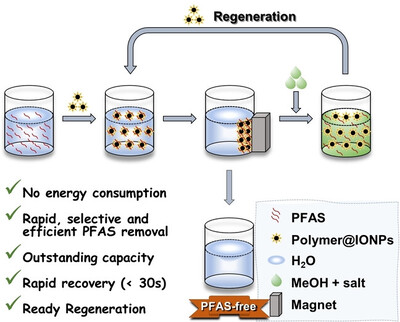Researchers trial magnetic resin to remove PFAS

A magnetic resin invented at The University of Queensland will be trialled at wastewater treatment plants to remove harmful ‘forever chemicals’ so sewerage can be safely reused as fertiliser.
The sorbent developed by Dr Cheng Zhang at UQ’s Australian Institute for Bioengineering and Nanotechnology (AIBN) has already shown promise as a safe and cost-effective filtration tool that removes per- and polyfluoroalkyl substances (PFAS) from water.
Zhang will lead a $7 million project with AIBN colleague Dr Zicheng Su and a consortium of commercial partners led by ViridAU to show his magnetic resin can also remove PFAS from semi-solid effluent.
The group plan to trial and scale up the resin at Australian treatment plants over the next three years using $5 million from commercial partners and a $2 million federal government Cooperative Research Centres Project (CRC-P) grant.
“Australia has about 700 wastewater treatment plants and they are among the last lines of defence we have when it comes to PFAS,” Zhang said. “But completely removing PFAS from the materials we flush down the drain — especially heavier organic matter – is not a simple task.”
“What we have created is a product that protects human and environmental health without completely re-engineering the systems already in place.”
Dual-purpose technology
Current biosolids treatment technologies for PFAS include high-temperature pyrolysis and incineration, both of which are energy-intensive and generate secondary pollutants.
Zhang said the resin removes PFAS through a magnetic ion-exchange technique that operates at room temperature.
Biosolids treated with Zhang’s magnetic resin can then be safety re-used as PFAS-free compost for agricultural and landscaping applications.
“Australia already produces more than a million wet tonnes of biosolids each year for land rehabilitation and agriculture,” Zhang said. “But PFAS is so pervasive that biosolids sold as fertiliser can still trigger environmental and regulatory concerns.
“The beauty of our technology is therefore in its dual purpose: protecting the environment from PFAS — and safeguarding downstream compost use and agricultural products.”

Zhang said the aim of the three-year CRC-P project was to produce a scalable product that puts Australia at the forefront of global PFAS management.
“As global regulations on PFAS discharge tighten — particularly in Europe and the US — there will be a growing need for advanced remediation solutions,” Zhang said. “Our technology will not only improve compliance with international standards, it provides safer access to products for irrigation and land management.”
Zhang’s PFAS sorption technology has been patented by UQ commercialisation arm UniQuest.
UQ’s Australian Institute for Bioengineering and Nanotechnology is hosting the 2025 National PFAS Symposium from 25–26 September.
Rosemount 490A optical dissolved oxygen sensor
The sensor is a digital Modbus-enabled measurement device designed to improve operational...
Kaeser GBS series rotary screw blowers
This range of blowers offers high efficiency and low maintenance and is suitable for applications...
Odosense Odour Emissions Tracking System
Odosense is an active odour analysis and public complaint validation system, which is suitable...







